Featured image credits: Lawrence Barringer, Pennsylvania Department of Agriculture, Bugwood.org licensed under a Creative Commons Attribution 3.0 License
licensed under a Creative Commons Attribution 3.0 License
Are you looking to learn about how to get rid of spotted lanternflies and stop the spread? These suggestions will be of benefit and save commercially significant crops.

 licensed under a Creative Commons Attribution 3.0 License.
licensed under a Creative Commons Attribution 3.0 License.A report from an economist reveals that the spotted lanternfly could plummet “Pennsylvania’s economy by at least $324 million annually.” This is owing to the invasive species unrelenting appetite for plants with strong economic significance. These commercial crops include grapevines, birch, black walnut, willow, among others.
Also, spotted lanternflies may affect the quality of life. These vibrant-spotted insects emerge in swarms and make life outdoors in your backyard difficult. Furthermore, after spotted lanternflies feed, they release honeydew. This sweet secretion attracts black sooty mold, which not only damage plants, but thrives on surfaces, such as decks and items kept outdoors. Sooty mold isn’t harmful to humans but causes damage to affected plants.
If spotted lanternflies are common property intruders where you live, take swift action. If the situation isn’t curtailed, many people may lose their jobs.
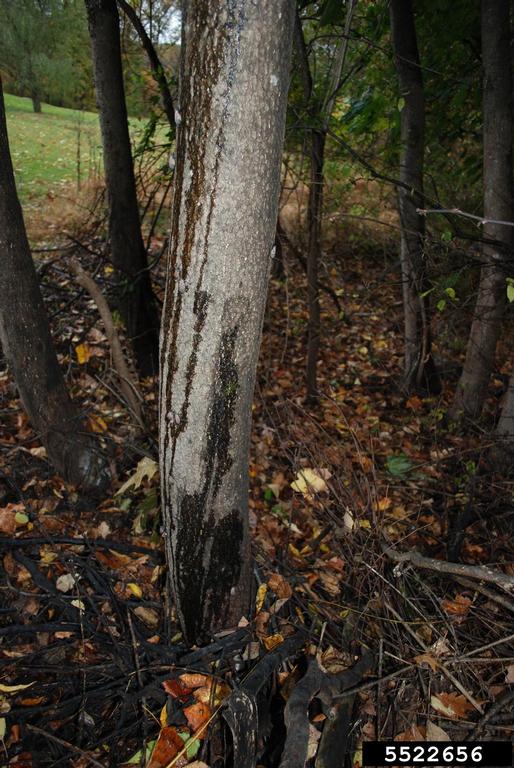
Pennsylvania Department of Agriculture , Bugwood.org
 licensed under a Creative Commons Attribution 3.0 License.
licensed under a Creative Commons Attribution 3.0 License.How to Get Rid of Spotted Lanternflies
To play your part in stopping the spread, it’s important to learn how to get rid of spotted lanternflies. There’s no single spotted lanternfly treatment. You may need to try a combination of best practises to keep this invasive species in check.
Also, these insects can’t be prevented from invading your property. This is disappointing, but spotted lanternflies (SLF) are migratory since they fly. To control the spread and get rid of spotted lanternflies, you may need to be continuous in your management efforts.
1. Squash the Bugs
Spotted lanternflies are almost inconspicuous during their nymphal stages. They are tiny, between 1/8” and 1/2”. During the early nymphal stage, their exterior is black and dotted white. However, their black exterior changes to red with black lines and prominent white spots during a lanternfly’s later nymphal stage.
Spotted lanternflies are better identified as adults. They are about an inch long, with beautiful, dotted wings that spread out.
When you come across this invasive species that affects agricultural and ornamental crops, admire their beauty for a second, but squash them afterwards. This is one of the most practical tips on how to get rid of spotted lanternflies, as it gets you up close and personal with the bugs.
Invite help if you must or solicit a young child’s help. They’ll have a field trip. Regardless of how it’s done, no spotted lanternfly should escape the bottom of your shoes.
2. Go Hunting for Egg Masses
Your hunt for spotted lanternfly egg mass won’t cure an already established infestation. However, it breaks the cycle.
Spotted lanternflies reel out egg masses around fall. Instars emerge from these eggs in spring, around May. Harsh winter conditions play a role in exterminating adult spotted lanternflies, but their eggs are protected.
Before they get an opportunity to hatch, your job is to search them out. This search, however, isn’t an exciting stroll through a park. It takes considerable effort and, in some cases, a whole lot of kneeling and crouching.
No worries, you’ll finally get to flex those muscles and showcase your acrobatic skills.
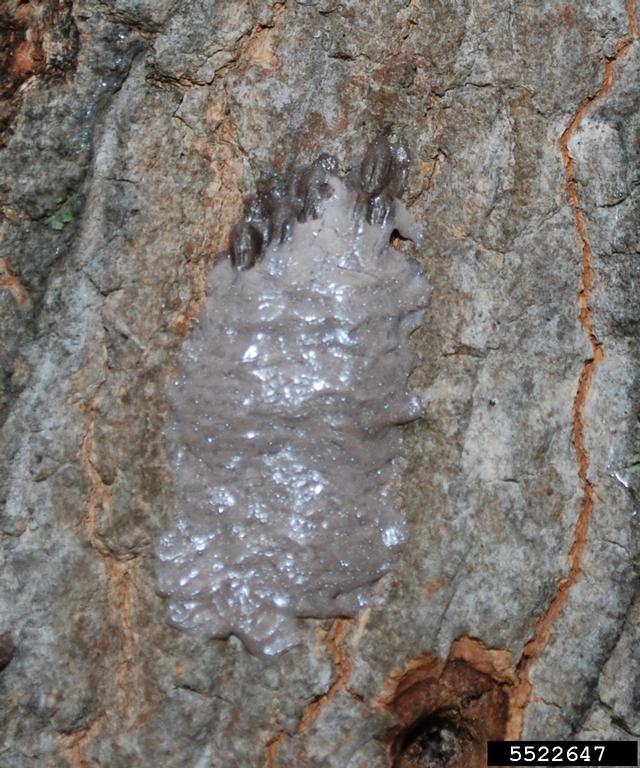
Pennsylvania Department of Agriculture, Bugwood.org
 licensed under a Creative Commons Attribution 3.0 License.
licensed under a Creative Commons Attribution 3.0 License.A spotted lanternfly will lay an egg mass on tough, hard surfaces. You may have results searching cement blocks, beneath your car, rocks, and trees. Some egg masses are laid in treetops, but please don’t go hunting for them by climbing.
You risk falling.
Do you have children play equipment stored outdoors? That’s a viable hatching spot for lanternflies. Ensure to give these equipment a good search.
How to Remove the Spotted Lanternfly Egg Mass
To remove the egg mass of a spotted lanternfly, a sturdy object with a flat surface will do. This includes a card or a putty knife. Some people also find that a stick does the job.
Whatever works for you.
After scraping the mass from the affected surface, drop it into a bag or container. It’s worthwhile to use a container with alcohol or hand sanitizer. Another effective option is to crush the eggs.
3. Stop the Spread
About 26 counties in Pennsylvania are under quarantine because of the presence of spotted lanternflies. Some states such as Delaware, New Jersey, and Virginia have reported sights of the colourful, mobilised insect.
When you travel from your abode or an infected area, exercise caution when leaving these zones. Check your possessions, including vehicle and outdoor tools before leaving. This is to identify egg masses, nymphs, or adult lanternflies.
When you park your automobile, avoid leaving the windows down. Also, consider the location in which you park. You may want to park in shaded areas, but sometimes that’s not ideal, since a tree might be infested.
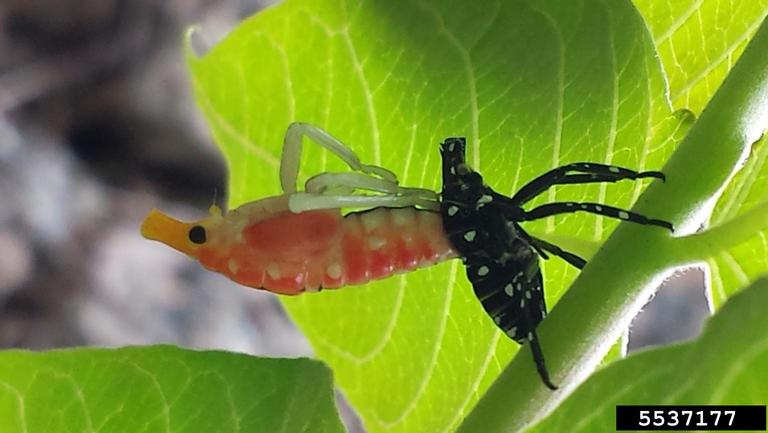
Lawrence Barringer, Pennsylvania Department of Agriculture, Bugwood.org
 licensed under a Creative Commons Attribution 3.0 License.
licensed under a Creative Commons Attribution 3.0 License.4. Trap Nymphs in their Tracks
After spotted lanternfly nymphs emerge from an egg mass, their objective is to feed. They will stroll up the host plant to snack. You can use their mobility against them.
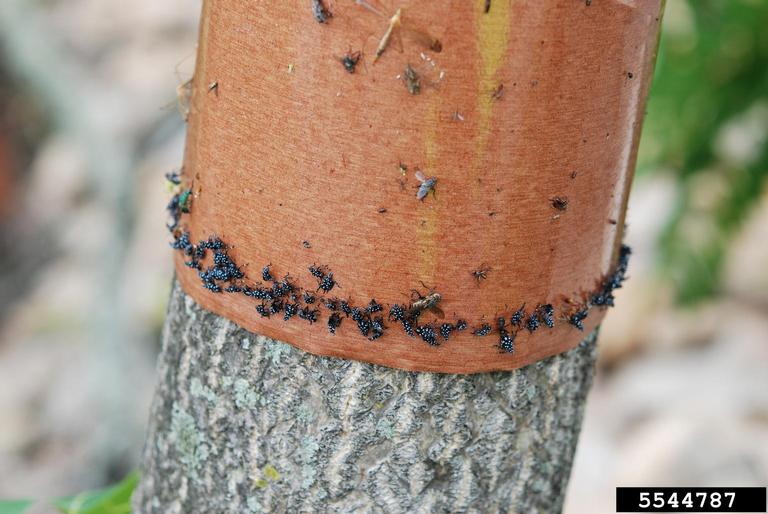
Lawrence Barringer, Pennsylvania Department of Agriculture, Bugwood.org
 licensed under a Creative Commons Attribution 3.0 License.
licensed under a Creative Commons Attribution 3.0 License.When you plant stick bands in their track, you can trap them. Nymphs tend to fall from the host plant to the ground, and then crawl back up. On the journey up, they will be caught. Some sticky bands will catch adult spotted lanternflies; however, they are more effective at catching nymphs.
You may need to cover over these traps to prevent birds from adhering to them.
Different types of tree banding traps include:
- Tanglefoot Tangleguard Banding Material and Tree Tanglefoot Insect Barrier
- Catchmaster Tree Banding Insect Adhesive Barrier
- W4W Giant Sticky Fly Trap Roll
5. Systematic Insecticide
This tip on how to get rid of spotted lanternflies is a long-term one.
Some chemicals kill spotted lanternflies after direct application. They are made to have direct contact with the target but may provide systematic or residual benefits. Once a lanternfly crawls over the substance, it might be killed.
Systematic insecticides are better suited for spotted lanternfly treatment. These can be applied right throughout the year but yields better results when done between July and September.
A professional or arborist may be required to apply some systematic insecticides. These include bark sprays, tree injections, and soil drenches. Do not attempt to apply these systematic chemicals, unless qualified to do so.
If you wish to use direct insecticides, try a spray that is intended for spotted lanternflies. Contact insecticides may contain active ingredients such as:
- Natural pyrethrins
- Beta cyfluthrin
- Bifenthrin
- Carbaryl
- Malathion
- Zeta-cypermethrin
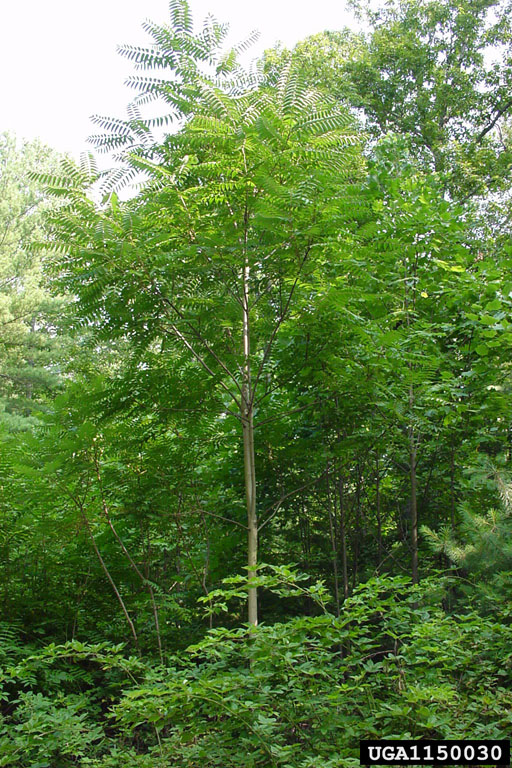
Chuck Bargeron, University of Georgia, Bugwood.org
 licensed under a Creative Commons Attribution 3.0 License.
licensed under a Creative Commons Attribution 3.0 License.6. Tree Removal
If there’s a tree that’s difficult to kill, but loved by spotted lanternflies, it’s the tree-of-heaven. It’s an invasive species that sprouts like wildfire and spreads its branches about 100 feet high. The spotted lanternfly does attack other trees, but this one seems to be a preference.
Do you have this tree on your property?
It’s important to get it removed if you want to slow the spread. It’s difficult to kill so you may need to solicit the service of an arborist or another qualified person. If you intend to tackle the job on your own, apply herbicide to the plant before removing. You should wait for about 30 days after applying the herbicide.
As the tree-of-heaven is stubborn, continuous application of herbicides until it’s completely killed is necessary.
The spotted lanternfly is an invasive species that damages plants of commercial significance. Play your part in curtailing the spread. Use this information on how to get rid of lanternflies and put things in place quickly. Also, contact your local Department of Agriculture to report sightings of the spotted lanternfly. That information helps them in their fight against the insect.






